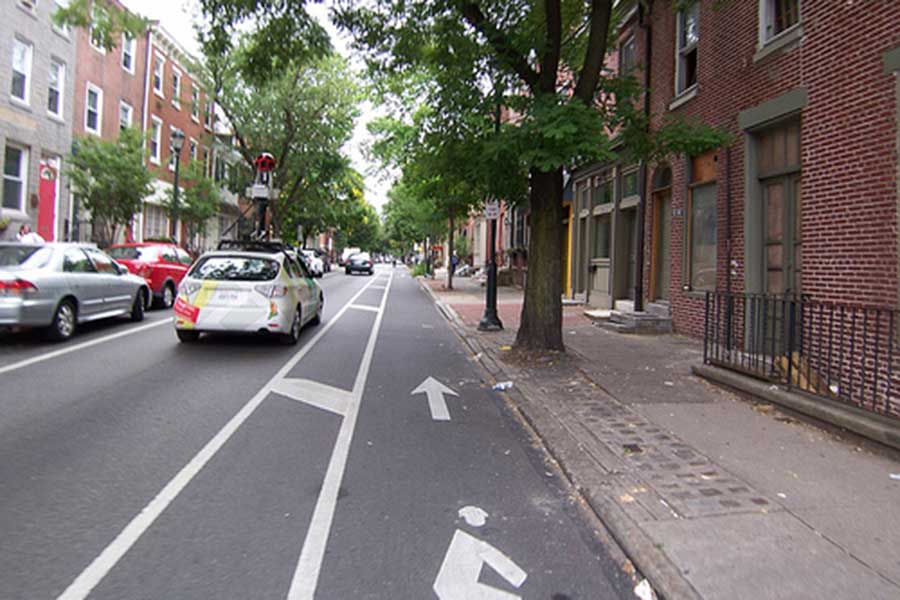The Gayborhood is getting a makeover in 2018. Some might call it long overdue.
The rainbow crosswalks that trim 13th and Locust streets have faded continuously since a week after the paint dried in June 2015. Meanwhile, the permanent closure of 12th Street Gym leaves the mural of LGBT activist Gloria Casarez on an abandoned building fated with demolition, if the fire code isn’t fixed. Plus, there are the potholes.
Here’s the good news: Spruce and Pine streets have repavement in their near future.
From Front to 22nd Streets, Spruce and Pine are set for construction under Philadelphia’s Office of Transportation and Infrastructure Systems’ plan to “increase safety for people walking, bicycling, riding transit, and driving along both corridors.”
The most noteworthy changes include flipping bike lanes from the right to the left side of the streets to increase biker visibility to drivers; moving the parking and loading zones from the right to the left; and refreshing worn crosswalks.
The renovation will not include the ragged rainbow walks one block over, confirmed OTIS pedestrian and bicycle program coordinator Jeannette Brugger.
Missing from OTIS’ proposal is the inclusion of protected bike lanes. Protected lanes were initially noted in the project’s early stages. As part of the $7.6 billion awarded by the Delaware Valley Regional Planning Commission to fund reconstruction, $300,000 was allotted to the project “Safe Space of Cyclists: Building a Protected Bicycle Network.” The project described including “flexible delineator posts” to separate auto traffic from bicyclists.
As it stands, protected lanes are not a part of the proposed Spruce/Pine reconstruction.
“These funds aren’t eligible for protected bike lanes,” said Brugger, directing further questions on protected lanes to the sticky-note station where attendees could write questions and concerns at last Thursday’s open-house meeting for Spruce and Pine Streets, East.
The decision to exclude protected lanes did not satisfy the bikers in attendance.
“I came out because I wanted to show my support for safety improvements, but also because I think they need to do more,” said Adela Park of South Philadelphia.
Park was hit by a car while riding her bike through the intersection of Spruce and Sixth streets this past year.
“I was on my way to work, riding in a bike lane, wearing my helmet, doing exactly what I was supposed to be doing, and I got hit. It’s ridiculous. Drivers are so crazy and there’s no awareness of how you should be sharing the road,” Park said.
She agreed that protected lanes could offer a solution to the “fend-for-yourself” environment of city commutes.
Residents affected by the construction were more concerned that OTIS was doing more harm than good by switching the lanes. Members of the Society Hill Civic Association expressed fears for the safety of drivers who would be forced to exit their cars into oncoming traffic following the proposed lane flip.
Deputy Manager of OTIS Michael Carroll responded, “I have not done a thorough analysis of all the car-door accidents, but generally speaking, there’s no difference in crashes from getting out on the right versus the left.”
Carroll’s answers did little to quell questioners, who feared that OTIS is “focusing on the pros and not acknowledging the cons.”
One woman in the crowd worried aloud about “the inconvenience of it all. There’s a parking space right in front of my house,” she said.
“I’m not living in a world where everyone can be comfortable,” Carroll said. “I would have to hear something that I was convinced was a safety hazard. If something that we hadn’t thought about demonstratively illustrates that we’re creating a safety problem, we’d have to stop. None of those things are rising to that level to say that this is a bad idea.”
Rather, the safety hazards are the bike lanes as they currently exist. In part, the repaving is in response to the two accidents on Spruce and Pine streets in the Gayborhood at the end of last year, both involving trucks, and one resulting in the death of a young woman on her way to work.
Running bike lanes on the left-hand side could be a crucial step forward for a city that is “behind many cities in the country as it pertains to physically protected bike lanes,” said Philadelphia Bike Coalition spokesperson Randy Lobasso in an interview with PlanPhilly.
As the meeting neared the end of its hour-and-a-half run time, Carroll continued to field questions amid a swamp of frustrated residents. One lone biker waited on the sidelines for a chance to bring up the ever-lessening likelihood of protected bike lanes.
A woman in attendance said to her partner, “They’ve already made up their minds.”
